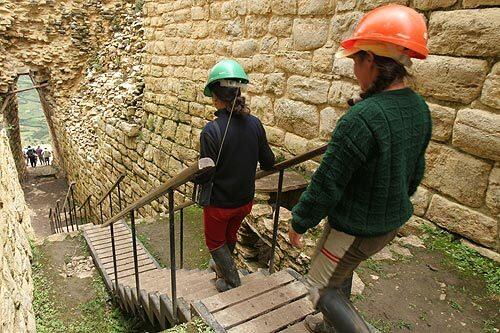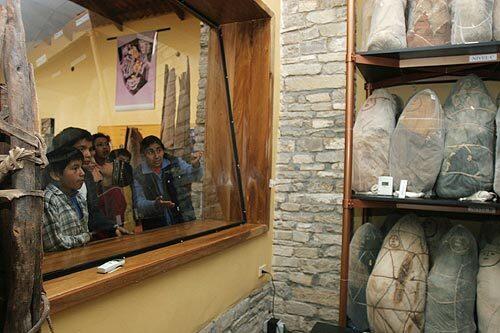Cloud warriors

This is the where the cloud warriors of ancient Peru once lived. Known from colonial chronicles as tall and fierce warriors who long resisted the Inca, the Chachapoya were also far-ranging merchants and powerful shamans. Recent digs at this majestic site have turned up scores of skeletons and thousands of artifacts, shedding new light on these myth-shrouded early Americans. (Liliana Nieto del Rio / For The Times)

A crew working on the dig handles stones that are part of the outer walls at Kuelap, the domain of the Chachapoya. Many bones and entire skeletons were embedded in the exterior ramparts. The Chachapoya are believed to have thrived from around 800 to about 1540, the last 70 years or so under the domination of their empire-minded neighbors, the Inca, and then the Spanish. (Liliana Nieto del Rio / For The Times)

Workers heading for a lunch break pass a burial site. The Chachapoya’s walled settlement, among the largest monuments of the ancient Americas, rivals the Incas Machu Picchu in scale and grandeur. The existence of Kuelap has been publicly known for more than a century, but in contrast to Machu Picchu, Kuelaps isolation long thwarted serious research. Now, Kuelap is slowly yielding its mysteries to the most rigorous scientific excavations to date, financed by the Peruvian government and the state of Amazonas. (Liliana Nieto del Rio / For The Times)

A breakthrough in Chachapoya scholarship was the recovery a decade ago of more than 200 well-preserved mummy bundles from a steep cliff above a sacred lake known as the Lagoon of the Condors. Looters initially found the more than 500-year-old funerary assemblage, leading to a salvage operation. The mummies were swaddled in cotton bundles, some embroidered with stylized faces. This mummy is among those on exhibit at a museum in Leymebamba, near the ruins. (Liliana Nieto del Rio / For The Times)
Advertisement

This skull, from an adult woman, is one of many unearthed in the dig at Kuelap. The Chachapoya, who thrived for centuries, declined suddenly in the first half of the 16th century. which has confounded experts. The Chachapoya suffered a demographic catastrophe in a short period of time, said chief archaeologist Alfredo Narvaez, noting that the population had probably dropped from several hundred thousand to perhaps 10,000 by the mid-16th century, after the arrival of the Spanish in Peru.
Evidence of a possible final calamity at Kuelap has been found in a platform near the Plaza Mayor, where excavators discovered scores of randomly scattered skeletons, of all ages and both sexes, mixed amid daily utensils. This was a striking departure in a culture in which departed loved ones were treated with great care and ceremony. (Liliana Nieto del Rio / For The Times)

Schoolchildren look at mummies at the museum in Leymebamba. The Chachapoya culture revered ancestors. (Liliana Nieto del Rio / For The Times)







